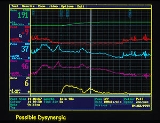
Bladder sphincter dyssynergia
Encyclopedia
Bladder sphincter dyssynergia (also known as detrusor sphincter dysynergia (DSD) (the ICS standard terminology agreed 1998) and neurogenic detrusor overactivity (NDO)) is a consequence of a neurological pathology such as spinal injury or multiple sclerosis
that disrupts central nervous system
regulation of the micturition (urination) reflex resulting in dyscoordination of the detrusor muscles
of the bladder and the external urethral sphincter muscles. In normal lower urinary tract function, these two separate muscle structures act in synergistic coordination. But in this neurogenic disorder, the urethral sphincter muscle, instead of relaxing completely during voiding, dyssynergically contracts causing the flow to be interrupted and the bladder pressure to rise.
On cystography
there is an irregular appearance of the bladder outline due to muscular contraction against the unrelaxed bladder sphincter.
and encopresis
are often associated with this condition.
trace or x-ray
findings, but the urodynamic trace in the image shows both the pressure and flow phenomena mentioned.
Multiple sclerosis
Multiple sclerosis is an inflammatory disease in which the fatty myelin sheaths around the axons of the brain and spinal cord are damaged, leading to demyelination and scarring as well as a broad spectrum of signs and symptoms...
that disrupts central nervous system
Pontine micturition center
The Pontine micturition center is a collection of cell bodies located in the rostral pons in the brainstem that is involved in the supraspinal regulation of micturition . The PMC makes connections with other brain centers to control micturition, including the hypothalamus, the cerebral cortex and...
regulation of the micturition (urination) reflex resulting in dyscoordination of the detrusor muscles
Detrusor urinae muscle
The detrusor urinae muscle, also detrusor muscle, muscularis propria of the urinary bladder and muscularis propria, contracts when urinating to squeeze out urine. Otherwise, it remains relaxed to allow the bladder to fill...
of the bladder and the external urethral sphincter muscles. In normal lower urinary tract function, these two separate muscle structures act in synergistic coordination. But in this neurogenic disorder, the urethral sphincter muscle, instead of relaxing completely during voiding, dyssynergically contracts causing the flow to be interrupted and the bladder pressure to rise.
On cystography
Cystography
In radiology and urology, a cystography is a procedure used to visualise the urinary bladder.Using an urinary catheter, radiocontrast is instilled in the bladder, and X-ray imaging is performed. Cystography can be used to evaluate bladder cancer, vesicoureteral reflux, bladder polyps, and...
there is an irregular appearance of the bladder outline due to muscular contraction against the unrelaxed bladder sphincter.
Pathology and symptoms
The pathophysiology of the condition results from neuronal plasticity associated with bladder afferents and motor neurons innervating the external urethral sphincter. Symptomatically, people with this condition generally experience daytime and night time wetting, urinary retention, and often have a history of urinary tract and bladder infections. ConstipationConstipation
Constipation refers to bowel movements that are infrequent or hard to pass. Constipation is a common cause of painful defecation...
and encopresis
Encopresis
Encopresis is involuntary fecal soiling in adults and children who have usually already been toilet trained. Persons with encopresis often leak stool into their undergarments.-Prevalence:The estimated prevalence of encopresis in four-year-olds is between one and three percent...
are often associated with this condition.
Diagnosis
Strictly DSD can only be diagnosed from an EMGElectromyography
Electromyography is a technique for evaluating and recording the electrical activity produced by skeletal muscles. EMG is performed using an instrument called an electromyograph, to produce a record called an electromyogram. An electromyograph detects the electrical potential generated by muscle...
trace or x-ray
X-ray
X-radiation is a form of electromagnetic radiation. X-rays have a wavelength in the range of 0.01 to 10 nanometers, corresponding to frequencies in the range 30 petahertz to 30 exahertz and energies in the range 120 eV to 120 keV. They are shorter in wavelength than UV rays and longer than gamma...
findings, but the urodynamic trace in the image shows both the pressure and flow phenomena mentioned.
External links
- http://www.springerlink.com/content/l381732rr087247p/
- http://www.sghurol.demon.co.uk/urod/pf.htm Pressure Flow Study, Department of Urology, Southern General Hospital, Glasgow

